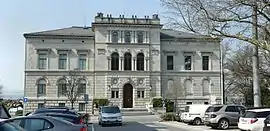Zug massacre
The Zug massacre took place on 27 September 2001 in the city of Zug (Canton of Zug, Switzerland) in the canton's parliament. Friedrich Leibacher shot dead 14 people before killing himself.[1]
| Zug massacre | |
|---|---|
| Location | Zug, Switzerland |
| Date | 27 September 2001 10:32 a.m. – 10:35 a.m. |
Attack type | Mass murder, mass shooting, murder-suicide |
| Weapons |
|
| Deaths | 15 (including the perpetrator) |
| Injured | 18 |
| Perpetrator | Friedrich Leibacher |
In the years before the massacre, Leibacher drew attention to himself by an intense use of lawsuits. These were dismissed, so he assumed he was being persecuted by the state; thus he felt he had to resort to the crime.[2] Leibacher was armed with a civilian version of a Stgw 90 (Swiss Army assault rifle),[3] a SIG Sauer pistol, a pump-action shotgun, and a revolver, and he wore a homemade police vest. Leibacher was able to enter the parliament building without problem.[4]
Attack

Leibacher started shooting in the hall where the members of parliament were meeting. He killed three members of the Executive Council ("Regierungsräte") and eleven members of the legislature ("Kantonsräte"), and wounded 18 politicians and journalists, some heavily. He fired 91 rounds. Then, he ignited a homemade bomb, and then took his own life.[4] His main intended target was the Cantonal Minister Robert Bisig, who was unharmed. Leibacher left a suicide note titled "Tag des Zornes für die Zuger Mafia" ("Day of wrath for the Zug mafia"), which referred to his belief there was a plot against him.[4]
This assault was the first of its type in Switzerland and one of the Canton of Zug's darkest days.[5] Worldwide, especially in the European Union and in the German Bundestag, there was shock at the attack.
Aftermath
Afterwards, many local parliaments increased their security or installed security measures. Some established a strict access control for visitors and security passes for the politicians and staff.
On the national level, the Sektion Sicherheit Parlamentsgebäude (section for the security of parliament buildings) was established as part of the Bundessicherheitsdienst (Federal Security Service), a police unit of 35, which secures the Bundeshaus in Bern. As part of a general electronic access control for visitors, access controls with X-ray machines were installed. Further, separate wings of the Bundeshaus were secured with gates, which have to be opened with a badge.
Many cantons and communities have compiled files of people who are considered Nörgler, Querulanten and Behördenhasser (nigglers, grumblers, haters of the administration), who have threatened people, filed lawsuits or bombard authorities with protest notes and who think they have been treated unfairly after the suits have been dismissed. Since the Zug massacre such people are watched closely. Mediation centres were founded in which the so-called Ombudsmänner try to mediate conflicts. Police stations became more sensitive to threats, with people making threats temporarily detained and their houses searched for weapons. When issuing weapon licenses, the application is closely examined, since Leibacher had been diagnosed with a paranoid personality disorder and "brain weakness" ("Gehirnschwäche"). He was legally able to buy the weapons although he had already threatened people, had been known as a querulous vexatious grumbler, and had had a report made against him.
Deaths
- Peter Bossard, member of the Cantonal Government.
- Monika Hutter-Häfliger, member of the Cantonal Government.
- Jean-Paul Flachsmann, member of the Cantonal Government.
- Herbert Arnet, president of the Cantonal Parliament.
- Martin Döbeli, cantonal councilor.
- Dorly Heimgartner, cantonal councilor.
- Kurt Nussbaumer, cantonal councilor.
- Rolf Nussbaumer, cantonal councilor.
- Konrad Häusler, cantonal councilor.
- Erich Iten, cantonal councilor.
- Karl Gretener, cantonal councilor.
- Willi Wismer, cantonal councilor.
- Heinz Grüter, cantonal councilor.
- Käthi Langenegger, cantonal councilor.
- Friedrich Leibacher (Spree killer, Zug)[4]
References
- "Gunman kills 14 in Swiss assembly". BBC News. 27 September 2001. Retrieved 3 March 2010.
- Fleck, Fiona (29 September 2001). "'Forgotten' row may have led to Swiss massacre". Telegraph.co.uk. Retrieved 3 March 2010.
- Switzerland Feels Chill of Insecurity After Shooting
- Untersuchungsrichterlicher Schlußbericht (German)
- The Zug Attack: It Can Happen Here